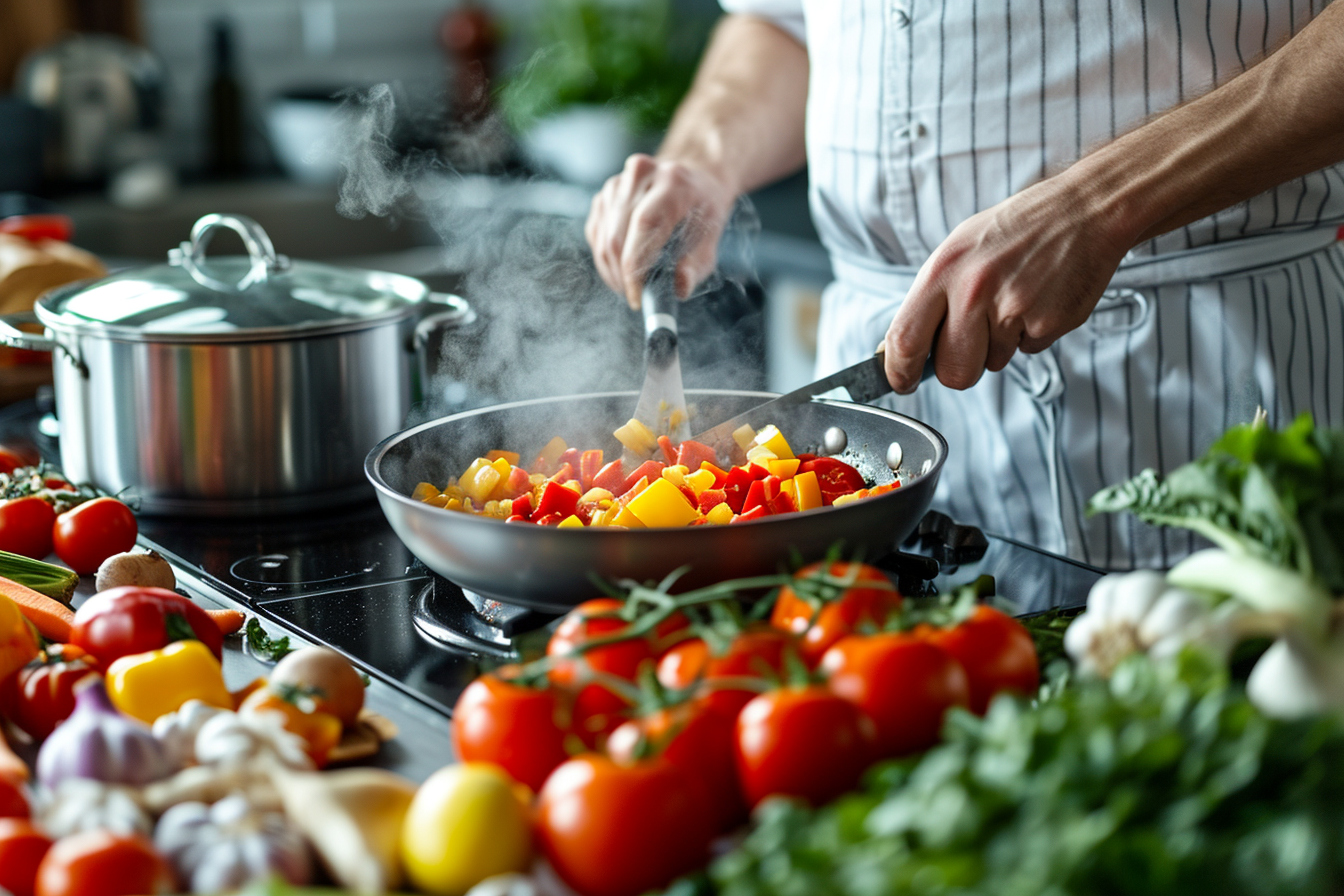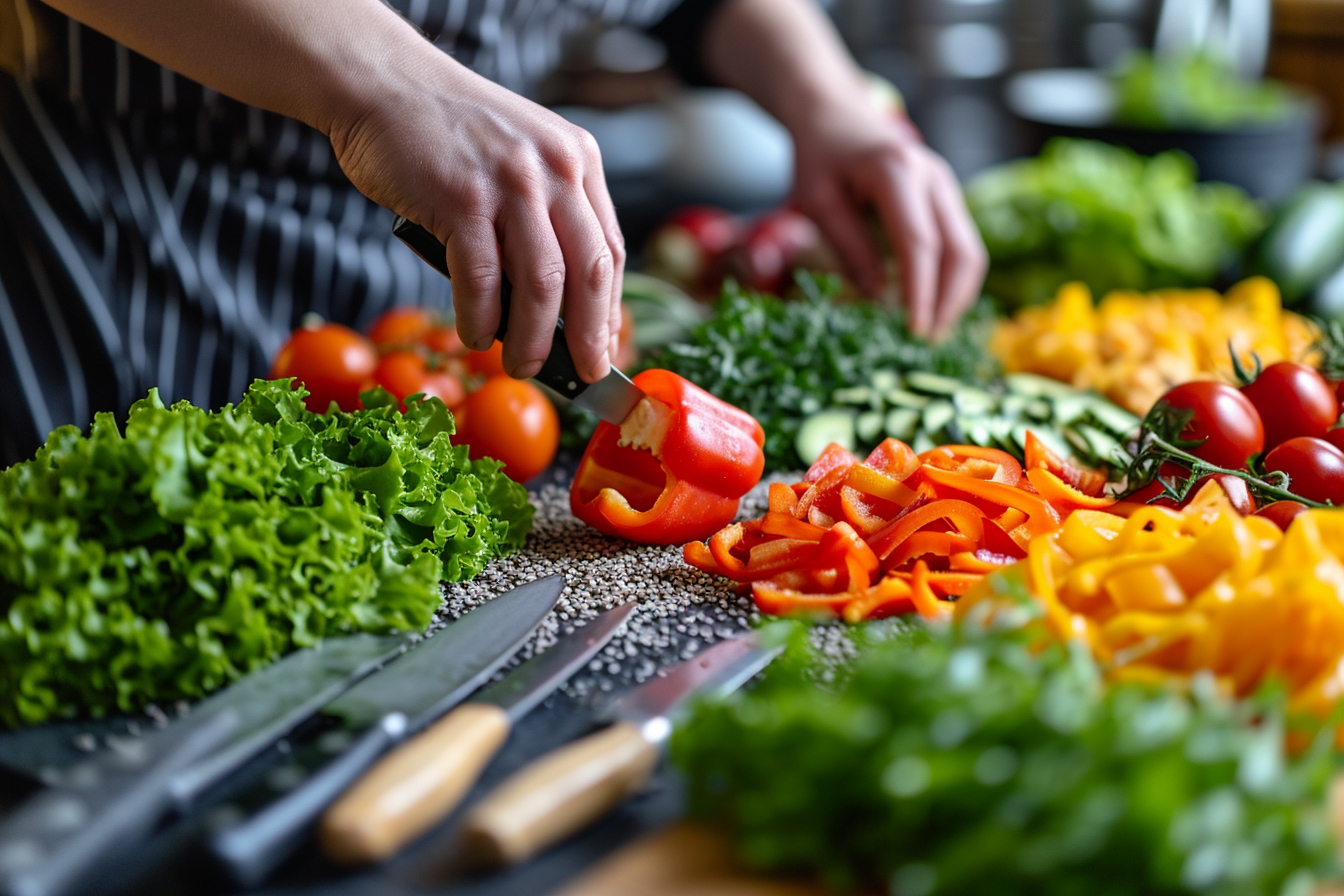
The journey to optimal health often leads individuals to the doors of vegan cuisine. Not only does a plant-based diet have the potential to reduce the risk of chronic diseases, but it also aligns with a sustainable lifestyle that many seek to adopt. However, the terrain of vegan cuisine is vast and, to the uninitiated, potentially daunting. Within the realm of vegan cooking, one can still find dishes heavy in oils and processed ingredients. The key to unlocking the full health benefits of a vegan diet lies in mastering low-fat vegan cooking techniques.
The foundations of low-fat vegan cooking
Understanding the pillars of low-fat vegan cuisine is essential. Nutritionally dense ingredients are at the heart of this approach. Grains, legumes, vegetables, fruits, nuts, and seeds form the basic building blocks, providing a rich tapestry of flavors, textures, and nutrients without necessarily adding excess fat.
Fats are not excluded; rather, their sources and the methods by which they’re integrated into dishes are thoughtfully considered. Whole food sources, like avocados, nuts, and seeds, are preferred over highly processed oils, allowing one to reap the benefits of fats with significantly more vitamins, minerals, and fiber.
Techniques to enhance flavor without added fat
One cannot discuss low-fat vegan cooking without addressing the matter of flavor. Traditional cooking often leans on fats to carry flavors. In contrast, low-fat vegan cuisine employs a variety of techniques to imbue dishes with depth and complexity.
Roasting and baking are longstanding methods for concentrating natural flavors. Vegetables like tomatoes, bell peppers, and onions undergo a transformation when roasted, their sugars caramelizing and resulting in a richer taste profile that can enrich soups, stews, and sauces.
Steaming is yet another technique at the vegan cook’s disposal. This method is ideal for preserving the integrity and nutritional profile of vegetables while softening them for incorporation into dishes. Adding herbs to the steaming water can impart subtle aromatics to the steamed items.
Sautéing is typically associated with the use of oil, but water or vegetable broth can be used instead to sweat vegetables like onions and garlic, which form the flavor backbone of many recipes. These alliums release their natural sugars even in the absence of oil, allowing them to become translucent and aromatic, a process known as water sautéing.
Marinating plays a pivotal role in imparting flavors into plant-based proteins like tofu, tempeh, and seitan. Utilizing vinegars, citrus juices, and flavorful liquid aminos or soy sauce, one can tenderize and season these proteins without any added fats.
Exploring diverse vegan ingredients
Diversity in ingredients not only prevents monotony but is also critical for nutritional balance. Exploring global cuisines opens up a plethora of ingredient options. Items like nori, miso, and tahini in Asian and Middle Eastern cooking provide umami and richness.
Textures play a crucial role in creating satisfying dishes. Legumes, such as lentils, chickpeas, and black beans, offer a hearty mouthfeel and can replace ground meat in recipes like tacos, bolognese, or burgers.
Creating richness without excess fat
Thickness and body are often associated with the richness in dishes, qualities typically achieved through the use of fats. However, alternatives exist in low-fat vegan cooking that deliver similar results.
Puréeing certain ingredients can create a creamy consistency without the need for cream or butter. Beans, when blended, can fortify soups and sauces with a substantial feel. Cauliflower is another versatile vegetable that, when steamed and puréed, delivers a silky foundation for dishes like alfredo sauce or mashed "potatoes."
Reduction techniques can intensify flavors and thicken sauces without adding fat. Simmering a sauce over low heat allows water to evaporate, leaving behind a more concentrated sauce that clings to pasta and vegetables more effectively.
Utilizing whole foods for natural fats
Harnessing the natural fats in whole foods is a sophisticated strategy in low-fat cooking. Nuts and seeds, when used sparingly, offer beneficial fats and can become the basis for dressings, sauces, or cheese alternatives.
Seeds like chia and flax can serve as thickeners when combined with water, creating gels that mimic the binding qualities of eggs in baking.
Rethinking traditional desserts
Desserts often represent a minefield of fats and sugars. Inventiveness is required to recreate these treats under the low-fat vegan paradigm. Base ingredients like bananas or applesauce can replace oils in baked goods, while dates or maple syrup provide natural sweetness.
Meal prep and planning: organizing for low-fat success
Effective meal planning is a fundamental aspect of sustaining a low-fat vegan lifestyle. It mitigates the temptation to reach for convenient, oil-laden options when hunger strikes. Preparing batches of grains, legumes, and roasted vegetables at the start of the week ensures that ingredients are on hand for quick assembly of meals.
Fine-Tuning with seasonings and spices
One should not overlook the power of herbs, spices, and seasonings in achieving flavor without fat. The judicious use of spices like cumin, coriander, and smoked paprika can transport a dish to another realm, providing warmth and complexity.
Managing portion sizes and caloric density
Attention to portion sizes and caloric density helps maintain balance in a low-fat vegan diet. It is crucial to be mindful of the energy provided by the foods consumed, creating meals with a variety of nutrient-dense and lower-calorie foods to satiate while supporting well-being.
Engaging with the vegan community for shared knowledge
Joining vegan communities and forums can open doors to shared knowledge, providing valuable insights and inspiration for low-fat cooking techniques. From potlucks to online groups, these communities foster an environment of support, where one can learn from the trials and successes of others.
Continuous learning and experimentation
A commitment to continuous learning and culinary exploration is indispensable for those striving to master low-fat vegan cooking. Cookbooks, workshops, and cooking classes provide avenues for growth, technical refinement, and the broadening of one’s plant-based repertoire.
The role of kitchen equipment in low-fat vegan cooking
Strategic investment in kitchen equipment can enhance the low-fat vegan cooking experience. High-speed blenders, non-stick cookware, and silicone baking mats empower the cook, reducing reliance on oils and facilitating the creation of diverse textures and dishes.
Sustainability and ethics: the greater impact of vegan choices
It’s worth considering the broader implications of embracing a low-fat vegan diet. Beyond personal health, this approach contributes to environmental sustainability and ethical considerations regarding animal welfare. Every meal becomes an opportunity to make choices that benefit both oneself and the planet.
Embracing creativity and flexibility in the kitchen
Finally, a spirit of creativity and flexibility is paramount. Rather than seeing low-fat vegan cuisine as restrictive, embracing its possibilities allows for an endless array of dishes, each nurturing and satisfying in its right. Substitutions and innovations are not only welcome but celebrated as part of the dynamic landscape of vegan cooking.
By mastering the techniques of low-fat vegan cooking, individuals not only nourish their bodies with healthful, plant-based meals but also participate in a larger movement towards sustainable living. As skills are honed and palates expand, the joy found in vegan cuisine can blossom into a lifelong passion, transforming the way we think about food and its impact on the world around us.

Leave a Reply